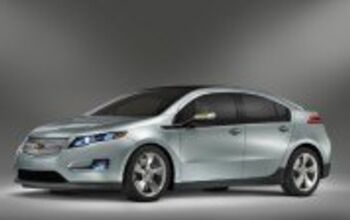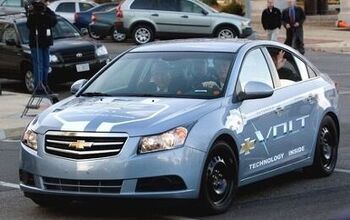Volt Birth Watch 133: No Confidence
Chevy’s Volt “will likely be too expensive to be commercially successful in the short-term,” reveals the PTFOA in what amounted to stunning news for Volt boosters and no one else. Wasn’t the Volt supposed to justify the whole bailout in the first place? The DetN‘s Scott Burgess takes the “yeah, but” tack, spinning expensive impracticality into farsighted vision. With a little help from his friends, of course. “In hybrid technology, it’s hard to argue that we’re not behind,” GM’s Rob Peterson tells Burgess. “But we believe we have a better solution.” And what of that $40K price tag that the government says will require “substantial reductions in manufacturing cost in order to become commercially viable?” “It’s a transformational technology,” says Peterson. “That’s part of the reason the cost is so expensive. But we believe if you start in the right direction, as the supply base matures, the volumes of the vehicle increases and the costs will go down.” If. As. Will. As in “we hope.” Meanwhile, someone has to pick up the bill and worry about the viability of a firm that is staking everything on an unprofitable-at-$40K moon shot. Needless to say that someone ain’t Bob Lutz . . . .
Having witnessed the horrors of the Wagoner shit-canning and the PTFOA Volt diss, gm-volt.com’s Lyle Dennis had to turn somewhere for an encouraging word. And who gives a better knee-deep-in-guts, battlefield pep talk than Maximum Bob Lutz? “Thanks for your concern,” writes Lutz. “Volt will survive and prosper. We know the numbers better than the Government…we furnished them! First-generation technology is expensive, but you can’t have a second generation without a first generation. Common sense and intelligence will prevail, here!”
As if to disprove Lutz’s point, a gm-volt.com post from a few days ago reveals that GM doesn’t know what the Volt’s MSRP will be yet. But the crazy part is the explanation why. They ‘re saying that fuel prices in 2011 will be the determining factor in setting the Volt’s price. “We’re not wishing for higher petroleum costs, but the economic viability of what we’re doing only gets greater with higher fuel prices,” GM’s Bob Kruse tells gm-volt.com, “$1.50 [a] gallon gas is not helping our business case.” The upshot though, is that GM will charge as much as it possibly can for the first generation of Volts because it won’t make money at any price point. And it seems that only the government is worried about the effect that this “charge what we can” scheme might have on GM’s competitivity.
More by Edward Niedermeyer
Latest Car Reviews
Read moreLatest Product Reviews
Read moreRecent Comments
- Dartman https://apnews.com/article/artificial-intelligence-fighter-jets-air-force-6a1100c96a73ca9b7f41cbd6a2753fdaAutonomous/Ai is here now. The question is implementation and acceptance.
- FreedMike If Dodge were smart - and I don't think they are - they'd spend their money refreshing and reworking the Durango (which I think is entering model year 3,221), versus going down the same "stuff 'em full of motor and give 'em cool new paint options" path. That's the approach they used with the Charger and Challenger, and both those models are dead. The Durango is still a strong product in a strong market; why not keep it fresher?
- Bill Wade I was driving a new Subaru a few weeks ago on I-10 near Tucson and it suddenly decided to slam on the brakes from a tumbleweed blowing across the highway. I just about had a heart attack while it nearly threw my mom through the windshield and dumped our grocery bags all over the place. It seems like a bad idea to me, the tech isn't ready.
- FreedMike I don't get the business case for these plug-in hybrid Jeep off roaders. They're a LOT more expensive (almost fourteen grand for the four-door Wrangler) and still get lousy MPG. They're certainly quick, but the last thing the Wrangler - one of the most obtuse-handling vehicles you can buy - needs is MOOOAAAARRRR POWER. In my neck of the woods, where off-road vehicles are big, the only 4Xe models I see of the wrangler wear fleet (rental) plates. What's the point? Wrangler sales have taken a massive plunge the last few years - why doesn't Jeep focus on affordability and value versus tech that only a very small part of its' buyer base would appreciate?
- Bill Wade I think about my dealer who was clueless about uConnect updates and still can't fix station presets disappearing and the manufacturers want me to trust them and their dealers to address any self driving concerns when they can't fix a simple radio?Right.


































Comments
Join the conversation
Ressler: "Prius and Volt are different cars, different architectures, different designs. A parallel hybrid, with neither powerplant optimized for exclusive motive use isn’t the same as a pure electric-drive car that has a range-extending generator fueled by hydrocarbons. Prius isn’t an electric car; Volt is." Examine the components in the car... the Prius is electric when it needs to be, ICE-driven when it needs to be and both when it's optimal to be both. Increase the battery, upsize the electric motors and it's an electric vehicle more often. Eventually, those components are large enough and/or the right price for it to be a serial electric. The Volt is a commitment to an uneconomic technology. As prices fall, the Volt becomes a more realistic purchase for the mainstream. In the interim, Toyota kicks GM's ass. Ressler: "Well, in fact, neither Ford nor Toyota has demonstrated they “know exactly how to [build an RE-EV or EV] .” GM has built and fielded a modern electric car in the past. I suggest you check out the Rav4-EV owner's gallery on EVNut.COM and refresh your memory as to which manufacturers have "built and fielded a modern electric car in the past." While you're doing that, you can reflect on which ones are still in the field. In fact, Toyota has participated in the development of an RE-EV. Check that same site for "long ranger," a trailer designed to extend the range of any electric car. Want elegance? The trailer idea allows the manufacturer to build an optimized BEV unhindered by range-extender overhead except when it needs it. No, Toyota didn't get too directly involved but they supported the project and undoubtedly learned from it. And I know how fond you are of a new paradigm... think about renting the range-extender only when necessary. You buy a BEV and you rent the range-extender only as necessary. This allows the ICE/generator end of the vehicle to be upgraded, modernized or resized as necessary for the task at hand. Caught somewhere with a flat can because you inadvertendly exceeded your BEV range? A Triple-A service of the future would include bringing you a range-extending trailer when you call in. Kix: "I’ve heard some assert they won’t buy the Volt because, although it is, kinda/sorta, an EV, it still has a gas engine in it. Ressler: "There’s always somebody who doesn’t get it. Not a stopper." Let me rephrase that, "I've heard some EV-fanatics assert..." Of course it's not a stopper but it's another chunk of a niche market they're not going to get. Ressler: "This is exactly why Volt makes sense. The development cost supports iterations for different prices and uses. It’s an electric car. Period. Selling a version sans the range extender is an incremental project and, sure, it should be an option. That’s not an argument for killing Volt." OK... so extending and modifying the Volt platform is natural and makes sense for the Volt. Toyota or Ford can change the parameters, relative sizes, capacities and ratings of their components (or even remove them altogether). But the Volt is superior partly because it can do this whereas the competition... also can do this. But they're inferior in this regard, anyway. Sure, I understand you. You should really spend more time over at GM-Volt. You'd fit in very, very well. Ressler: "If Toyota or Honda built a Volt-style series hybrid, it would outsell their parallel hybrids once the market understands the difference." Another assertion without a shred of evidence. People will buy a vehicle that meets their transportation needs at a good price. They are averse to large up-front investments with paybacks in excess of a couple years (although technophiles can be persuaded to do certain things for the gee-whiz factor... those with the means, anyway).